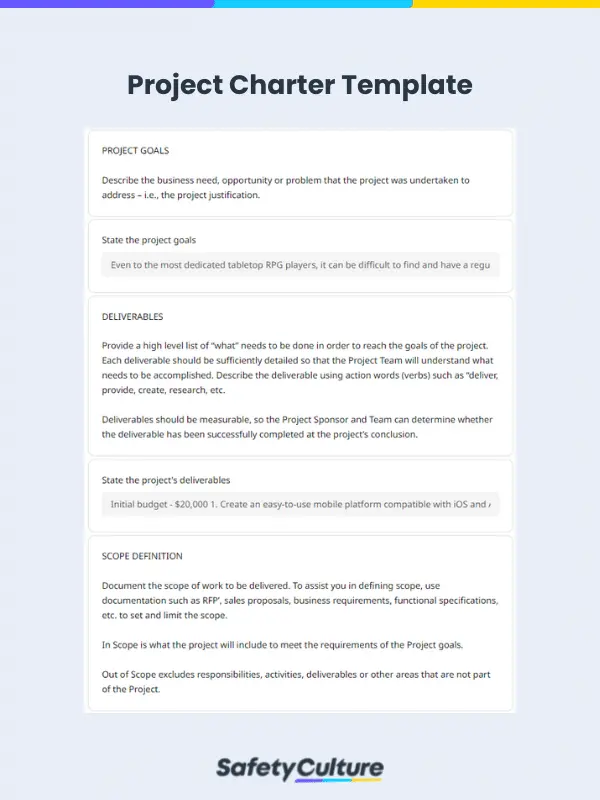What is a Project Charter Template?
A project charter template is a guide used by project managers when drafting detailed project plans called project charters. A typical project charter template provides fields for the relevant aspects of a given project, including the reasons for the project, its objectives, scope and limitations, identified risks, perceived benefits, deliverables, proposed budget, and personnel involved.
What is the Purpose of a Project Charter?
A project charter is an official, internal document typically drafted by project managers in collaboration with the business manager. A project charter includes the important details of an approved project such as its purpose, scope, objectives, identified risks, milestones, budget allocation, and key stakeholders involved in its implementation.
A project charter serves mainly as a team’s reference guide that they can go back to throughout the project life cycle. It aims to help teams stay coordinated by ensuring that everyone is aware of each member’s role and in estimating the workload of each, the necessary deadlines to meet, and the risks that should be avoided in the process of completing the project’s objectives.
5 Common Mistakes When Developing a Project Charter
Knowing how to properly fill out a project charter form can help teams achieve their goals with greater efficiency and fewer setbacks. A comprehensive, well-written project charter should avoid the following mistakes in order to serve its purpose:
1. Micromanaging assignments
A project charter is expected to be detailed and specific to avoid ambiguity and misunderstandings. Too much specificity on how tasks should be accomplished, however, crosses over into micromanagement. Team members may feel too restricted with this management style, negatively affecting productivity, trust, and morale.
Solution:
If you are working with a new team, take time to know each member’s strengths before assigning them a particular task and role in the project charter. By doing so, you can rest assured that they have the skill set and ability to accomplish their tasks without having to worry too much about mistakes or substandard output. Creating a work breakdown structure during the project planning can also help in efficiently assigning tasks to team members.
2. Drafting a project charter based on assumptions rather than data
Even experienced managers can make incorrect assumptions about the proper scope, achievable goals, and realistic timeframes when drafting project charters. As a consequence, the team may realize halfway through implementation that they are ill-equipped and under-resourced to accomplish the project goals.
Solution:
Before determining the end goal, project managers must gather relevant data to ensure that the project will address the root cause of the problem instead of mere symptoms. Performing a root-cause analysis can help ensure that the team is tackling the right problems with the proposed project.
3. Poor awareness of available resources
In order to fill out your project charter template with SMART goals, you must be aware of the resources you have at your disposal. Poor awareness of available resources can lead to unnecessary outsourcing of work, excess expenditure, and unrealistic expectations.
Solution:
Once you have determined that you are addressing the right problem in your project charter, list the resources you need in order to achieve the project goals. Ask around the organization for people, assets, equipment, and tools you may use to achieve the project goals. This will make it easier to come up with realistic and achievable project goals.
4. Failure to acknowledge possible risks
Just as it is important to determine goals and project milestones, project managers also need to make an effort to identify the risk factors. Failure to acknowledge realistic hazards may leave the team unprepared and unable to recover when problems do occur, causing delays, or worse, project failure.
Solution:
Project managers can benefit from using a simple risk assessment template in tandem with a project charter template to classify project risks according to likelihood and urgency. Additionally, a CAPA Report provides a framework for creating both corrective and preventive actions that will help prepare your team should risks escalate into actual issues.
5. Focusing only on the input of high-level management
Some project managers focus only on the input of the business manager and other high-level stakeholders, deeming their opinion the most important. Though this is true to some extent, failing to acknowledge the input of other personnel involved, especially the team that will directly implement the project, can lead to missed opportunities for valuable insight.
Solution:
At the onset of drafting the project charter, take time to speak to team members and minor stakeholders and ask for their input on your proposed goals and milestones. Ask them about the average timeframes for certain tasks, what the current process is like, and regulatory and organizational requirements you will need to comply with. By doing so, you can optimize your project charter according to realistic constraints.
The project charter is a major factor in determining the success rate of implementation. In order to serve its purpose, it must clearly outline the project’s goals, risks factors, and data-driven insights.



